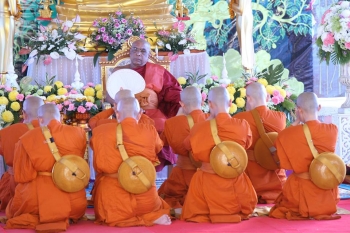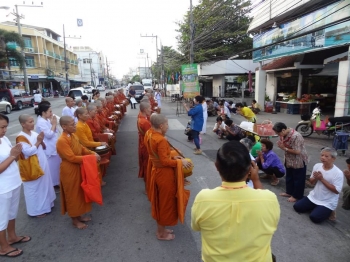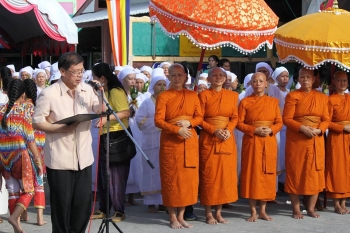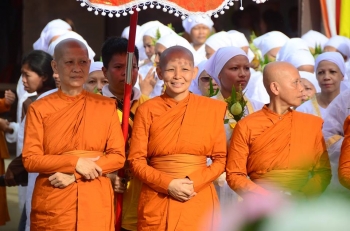 From Thippayasathandhamma Bhikkhuni Arama
From Thippayasathandhamma Bhikkhuni Arama From Thippayasathandhamma Bhikkhuni Arama
From Thippayasathandhamma Bhikkhuni Arama From Thippayasathandhamma Bhikkhuni Arama
From Thippayasathandhamma Bhikkhuni Arama From Thippayasathandhamma Bhikkhuni Arama
From Thippayasathandhamma Bhikkhuni AramaOn 29 November, 8 bhikkhunis and 47 novices were ordained at Thippayasathandhamma Bhikkhuni Arama, a nunnery located on the islet of Koh Yor in Thailand’s Songhkla Province. The ceremony was performed by both male and female monastics from Sri Lanka, who were invited specifically by Venerable Dhammananda, abbess at Wat Songdham Kalayani, in the central Thai province of Nakhon Pathom. In response, on 11 December the Sangha Supreme Council of Thailand (SSC) released a statement that forbade monks from ordaining women and demanded that foreign monks secure permission from the government before holding ordinations in Thailand. The statement further declared that the bhikkhuni lineage in Sri Lanka was discontinued and unrecognized by both countries. According to the statement, ordaining bhikkhunis in Thailand with the help of bhikkhus and bhikkhunis from East Asia is also invalid.
This was a dramatic affirmation of the prohibition against ordaining women in Thailand and a sour end to 2014 for Buddhist feminists. Of course, it is questionable how much effect official statements like this will have. After all, the control that Thailand’s highest religious powers exercise over women is weakening, and their image as an out-of-touch clique cannot help. Nevertheless, institutional opposition to women’s ordination is so entrenched that even senior bhikkhunis like Ven. Dhammananda have “Mrs.” stamped on their passport, a nonsensical and insulting rebuff.
In a country that purposefully adopted the model of centralized authority for its state religion, the council’s statement could be read as a warning against foreign sanghas interfering in Thai spiritual affairs. It can also be seen as a defensive protest against a changing world. Many Theravada laypeople and monastics, including many Thais, tacitly or openly support the full ordination of women—and along with this, are throwing many other gender issues in Theravadin cultures into the limelight. For neutrality’s sake, it is important to assume that the council’s argument was made in good faith, and that senior members are genuinely concerned with the legality of ordaining women according to the Theravada Vinaya.
The alleged extinction of Theravada bhikkhunis in Sri Lanka or elsewhere is already contradicted by contemporary fact: there are plenty of Theravada monastics living the religious vocation, many of them in Thailand, where there are 80 bhikkhunis spread across 20 provinces. Furthermore, the premises of the statement are questionable. “The position of the council is
based on the assumption that the ordination was flawed. This assumption is incorrect,” says Ven. Analayo of Hamburg University, one of the most formidable minds in the Theravada world. In a breakthrough article about the ordination of bhikkhunis under Fo Guang Shan’s Master Hsing Yun at Bodhgaya in 1998, Ven. Analayo demonstrated that it was legally possible to ordain Theravadin women through a different Vinaya such as the Dharmaguptaka (the code used by most East Asian monastics). In this and subsequent pieces, he also demonstrated that it was perfectly legal for monks to ordain women, even without a pre-existing community of bhikkhunis.
In the ancient days of the foremost disciples, Shakyamuni Buddha gave bhikkhus the authority to ordain bhikkhunis (set out in Cullavagga X.2, the second volume of the Khandhaka, the second book of the Theravada Vinaya). After he ordained his stepmother, Mahapajapati, he approved a dual ordination ceremony in which bhikkhunis would first be ordained by a community of bhikkhunis, before being approved by a community of bhikkhus (Cullavagga X.17). In the history of monks’ ordination, Shakyamuni Buddha would abrogate an old method before introducing a new one. When the Supreme Patriarch of Thailand issued a prohibition against ordaining women in 1928, it was understood that Shakyamuni Buddha had abrogated his first permission for monks to ordain bhikkhunis to allow for the second rule of dual ordination. But if the community of bhikkhunis needed for the dual ordination process was extinct (as the SSC argues), then further ordinations would be impossible.
Ven. Analayo argues that from the narrative context, it is clear that the Buddha did not abolish the original principle of monks ordaining bhikkhunis. His second method of ordination was meant for a completely different situation: a context in which there was an extant bhikkhunis’ order as opposed to a non-existent one, which the first rule covers. Ven. Analayo has made it part of his academic calling to point this out to intellectuals who disagree with women’s ordination, such as the erudite and respected Thai monk Phra Payutto (Payutto and Seeger 2013):
“Contrary to the assumptions by Phra Payutto and Bhikkhu ?hanissaro, what we have here is not just an early rule and its subsequent adaptation. Instead we have two rules on related but different issues. . . . There can be only one situation at a time: Either a community of bhikkhunis is in existence, in which case Cullavagga X.17 is to be followed, or else a community of bhikkhunis is not in existence, in which case Cullavagga X.2 is to be followed” (Analayo 2014, 7).
Ven. Analayo remains convinced that the resistance of traditional elders is closely linked to their belief that ordaining women is against Theravada law. “If they could be made aware of the fact that other monastics, who are also academic scholars, have argued in detail that this is not the case, and the arguments are available in their language, the situation could profoundly change—which is precisely why I put so much energy into writing these things,” he tells us. It is therefore urgent for Buddhists who believe in the legal, moral, and historical correctness of women’s ordination to help spread the good news.
References
Analayo, Bhikkhu. 2014. “On the Bhikkhuni Ordination Controversy.” Sri Lanka International Association of Buddhist Studies III: 1–20.
Payutto, Phra, and Martin Seeger. 2013. The Buddhist Discipline in Relation to Bhikkhunis: Questions and Answers. Translated by Robin Moore. N.p.: privately printed.
For further information, see:


















